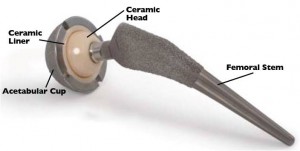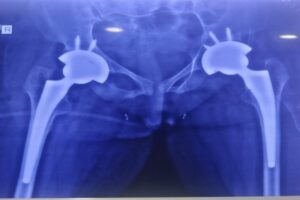Hip Replacement Surgery
Hip is the part of the human body where the thigh bone joins with the hip bone. In this joint, the ball like the top part of the thigh bone swivels in the socket like acetabulum which is situated in the pelvis. Arthritis or sudden heavy pressure applied in accidents or sports activity may damage the cartilage covered portion of the hip joint, that can cause severe pain and damage to the hip joint. The same could also be the result of a condition called avascular necroses of the hip which is caused due to damage to the blood supply of the femoral head(ball). Several factors can result in damage to the blood supply of the femoral head(ball) which can lead to the collapse of the femoral head and can turn to severe arthritis in terminal stages. The only solution to this devastating situation is the removal of the existing hip joint by a prosthetic hip joint – Hip Replacement.
What is Hip Replacement?
Hip replacement surgery is a very successful and common procedure adopted by the orthopedic surgeons all over the world. In this surgery, the femoral ball of the thigh ball is replaced by a synthetic ball and is allowed to articulate in a prosthetic socket connected to the pelvic bone. Such a replacement of the hip has been found to be very successful and pain relieving to almost all of the patients who had undergone such surgeries. For 90% of the patients, it has been found to be functioning satisfactorily for 10 years and for 80% of patients the success period is 20 years.
The type of hip replacement suitable for a person is decided by considering many factors like the damages caused to the hip joint, age and activity level of the person etc. It has also to be born in mind that the recovery period in some hip replacement methods may be lesser and the succeeding period of some type of hip replacements may be longer.
Considering all the above factors your surgeon will suggest the best method of Hip Replacement that can be adopted for you.
Ceramic Hip Replacement

So ceramic hip replacement is the most suitable method for younger people in the age group of 40 – 50, as they last longer and the complicated revision hip replacement surgeries are not necessitated in this case. But there is no scientific data to prove how long they will stand without erosion. It is expected that they will stand for about 30 years as their use in other orthopedic departments had given ample data to prove their superiority over plastic and metal implants. As the ceramic prostheses are the latest entrant in this arena, the exact rate of wearing of this material is not available now. But it has been found that the rate of wear of ceramic prostheses is only 0.32 mm per 3 million cycles of abrasions.
Bipolar Hip Replacement
When an injury is caused in the femur near the hip, the ball in the hip has to be replaced for enabling the hip joint to perform its normal functions. The fracture occurring in this part of a thigh bone cuts the blood supply causing severe damage to the joint which cannot be controlled by any medication. The only solution to this problem is the replacement of the hip joint either partially or totally depending upon the damages caused. The surgical procedure for repairing the hip joint by replacing it with a prosthesis is known by the medical term hemiarthroplasty. In hemiarthroplasty, the socket of the hip joint is not replaced. As only a part of the hip joint is replaced in this procedure, it is known as a partial hip replacement.
Bipolar hip replacement is usually recommended for older patients and for patients with poor health, as the rubbing of a metal ball in the bone socket in unipolar hip replacement will not be suitable for them.
Total Hip Replacement

It is a procedure in which a physician surgically removes a diseased hip joint and replaces it with an artificial joint called as a prosthesis. The artificial joint is made up of a ball component of either metal or ceramic and a socket, which has a liner made of plastic or metal. The artificial implants used in total hip replacement are biocompatible meaning they are designed to be accepted by your body.
Total hip replacement surgery is performed on patients with hip joint damage from osteoarthritis or an injury. The other possible causes of joint deterioration are inflammatory arthritis, hip disorders of infancy and trauma.
Total hip replacement is only recommended when all other conservative treatments fail to yield any result and the patient continues to suffer from significant pain, stiffness or problems with hip function.
Surgical Procedure
Total hip replacement is performed only after the patient is given anesthesia. The surgeon makes small incisions over the front side of the hip through tissue layers. The damaged bone and cartilage are then removed from the hip and replaced with an appropriate prosthesis. The nature and type of prosthesis depend on the needs of the particular patient and the doctor performing the surgery. This man-made joint is specially designed to function in the same natural, gliding motion as that of an active hip joint.
Recovery Process
Physical therapy has a significant role in the recovery process after Total Hip Replacement. Most of the patients are able to stand and even walk with the help of a therapist, within 24 hours.
The rehabilitation program normally includes some exercises related to the muscles surrounding the hip joint, as wells as training in activities of daily life (stair climbing, walking, bending). The main objective of this rehabilitation process is to regain strength and motion. Almost 90 percent of the people can resume their normal activities within three to six months. In general, hip replacements last 10 to 15 years or longer and most people are very much satisfied with the result.
Consult Dr. Biren Nadkarni one of the best hip replacement surgeons in India who is performing Joint Replacement Surgeries on high rate of success .
FAQs
-
What is hip replacement surgery, and who is the best hip replacement surgeon in Delhi?
Hip replacement surgery is a procedure in which damaged parts of the hip joint are replaced with an artificial joint. The best hip replacement surgeon in Delhi is Dr. Biren Nadkarni who has rich and dynamic experience in performing Hip Replacement Surgery.
-
What are the benefits of hip replacement surgery, and how long does it take to recover?
Hip replacement surgery can relieve pain, improve mobility and function, and allow patients to resume their normal activities. Recovery time varies from patient to patient, but it typically takes about 6-12 weeks to fully recover and return to normal activities.
-
How do I prepare for hip replacement surgery, and what should I expect during the procedure?
Preparing for hip replacement surgery involves meeting with your surgeon, getting a medical evaluation, and making necessary lifestyle changes such as quitting smoking or losing weight. During the procedure, the surgeon will make an incision, remove damaged parts of the hip joint, and replace them with an artificial joint.
-
Is hip replacement surgery painful, and how can I manage my pain after the procedure?
Hip replacement surgery can cause some pain, but medication and other pain management techniques can help to alleviate it. After the procedure, patients may be given pain medication, use ice packs or heat therapy, and undergo physical therapy to help manage pain.
-
What are the risks and complications associated with hip replacement surgery, and how can they be avoided?
Some risks and complications associated with hip replacement surgery include infection, blood clots, and implant failure. These risks can be minimized by choosing a skilled surgeon, following post-operative care instructions, and maintaining good overall health.
-
How long does hip replacement surgery take, and what is the success rate of the procedure?
Hip replacement surgery typically takes 1-2 hours to complete. The success rate of the procedure is high, with over 90% of patients experiencing significant improvement in pain and mobility.
-
What type of anesthesia is used for hip replacement surgery, and what are the alternatives?
Hip replacement surgery can be performed using general anesthesia, regional anesthesia, or a combination of both. The type of anesthesia used will depend on the patient's medical history and the surgeon's preference.
-
How much does hip replacement surgery cost, and is it covered by insurance?
The cost of hip replacement surgery can vary depending on factors such as the surgeon's fees, the hospital fees, and the type of implant used. It may be covered by insurance, but it's best to check with your insurer beforehand.
-
What is the difference between a total hip replacement and a partial hip replacement?
In a total hip replacement, the entire hip joint is replaced with an artificial joint. In a partial hip replacement, only the damaged or diseased part of the hip joint is replaced.
-
Can hip replacement surgery be done on an outpatient basis, or does the patient need to stay in the hospital?
Hip replacement surgery is typically done in a hospital setting, and patients will usually stay in the hospital for a few days after the procedure. However, some patients may be candidates for outpatient hip replacement surgery.
-
What are the best exercises for rehabilitation after hip replacement surgery, and how long does the rehabilitation process take?
Rehabilitation exercises after hip replacement surgery may include range of motion exercises, strengthening exercises, and balance and coordination exercises. The rehabilitation process can take several months, depending on the patient's condition and progress.
-
What should I expect during my recovery after hip replacement surgery, and how can I best support my healing process?
During recovery, patients can expect to undergo physical therapy, gradually increase their activity level, and monitor their pain and healing progress. It's important to follow your surgeon's instructions and take steps to promote healing, such as getting enough rest, eating a healthy diet, and avoiding activities that may put strain on the hip joint.
-
Can hip replacement surgery be done using minimally invasive techniques, and what are the benefits of this approach?
Yes, hip replacement surgery can be performed using minimally invasive techniques, which involve making smaller incisions and using specialized surgical instruments. Benefits of this approach may include less pain, faster recovery time, and smaller scars.
-
What should I do if I experience complications after hip replacement surgery?
If you experience complications after hip replacement surgery, such as increased pain, swelling, or redness, it's important to contact your surgeon or healthcare provider right away. They can evaluate your symptoms and recommend appropriate treatment.
-
How can I find the best hip replacement surgeon in South Delhi, and what factors should I consider when choosing a surgeon?
To find the best hip replacement surgeon in South Delhi, you can ask for recommendations from your primary care doctor, friends or family, or search online for reviews and ratings. When choosing a surgeon, factors to consider include their experience, expertise, credentials, and patient satisfaction ratings.
